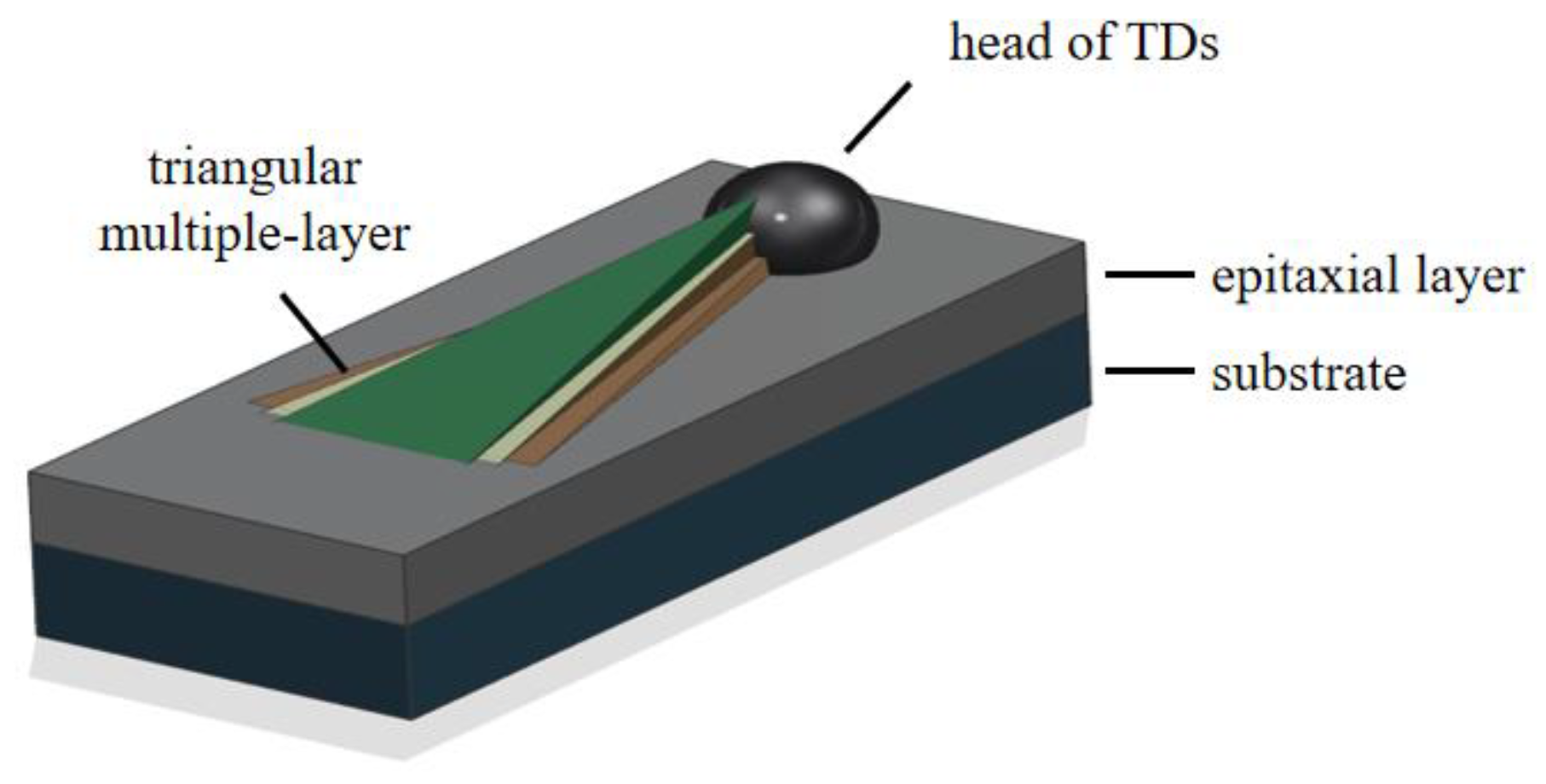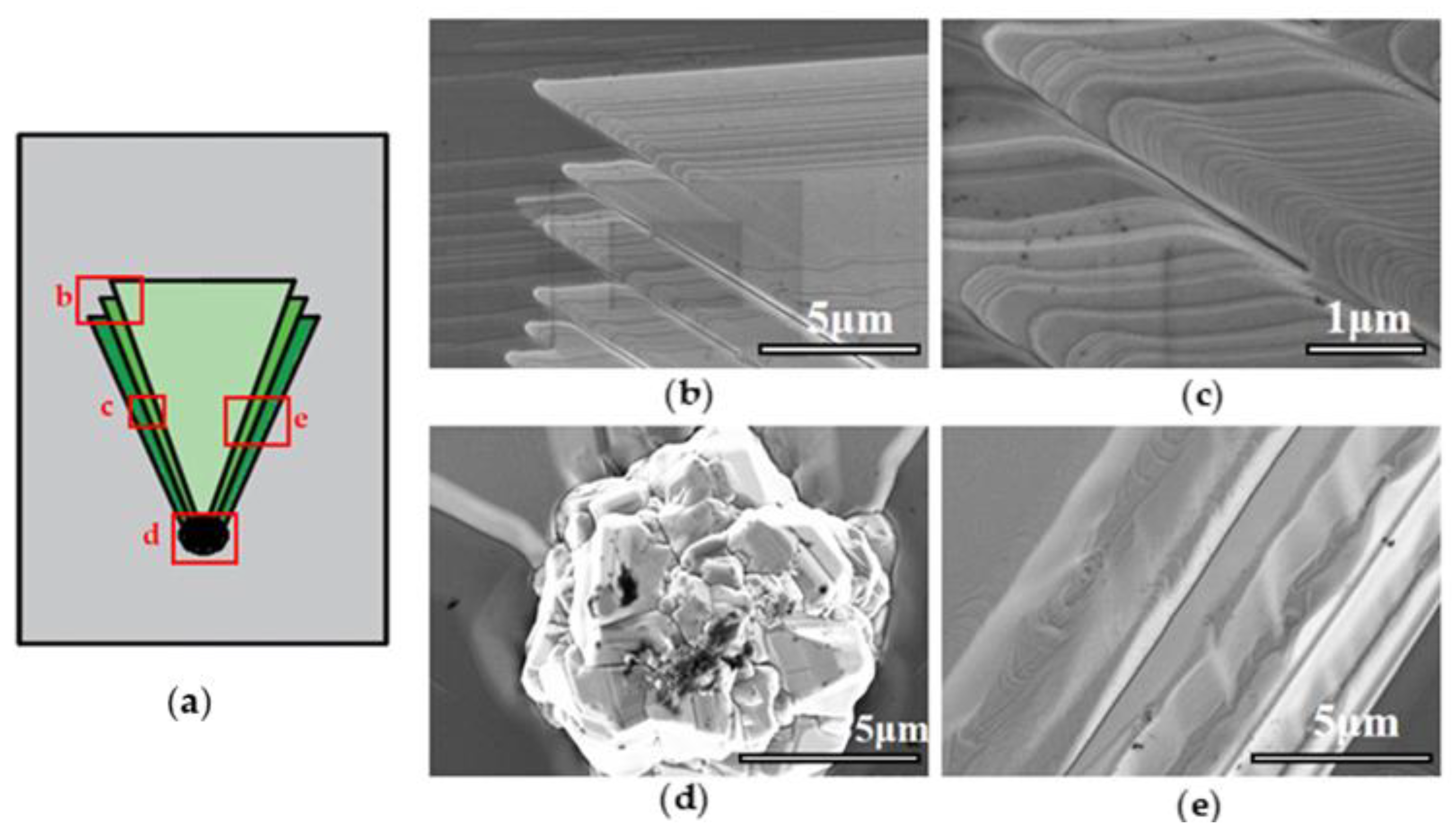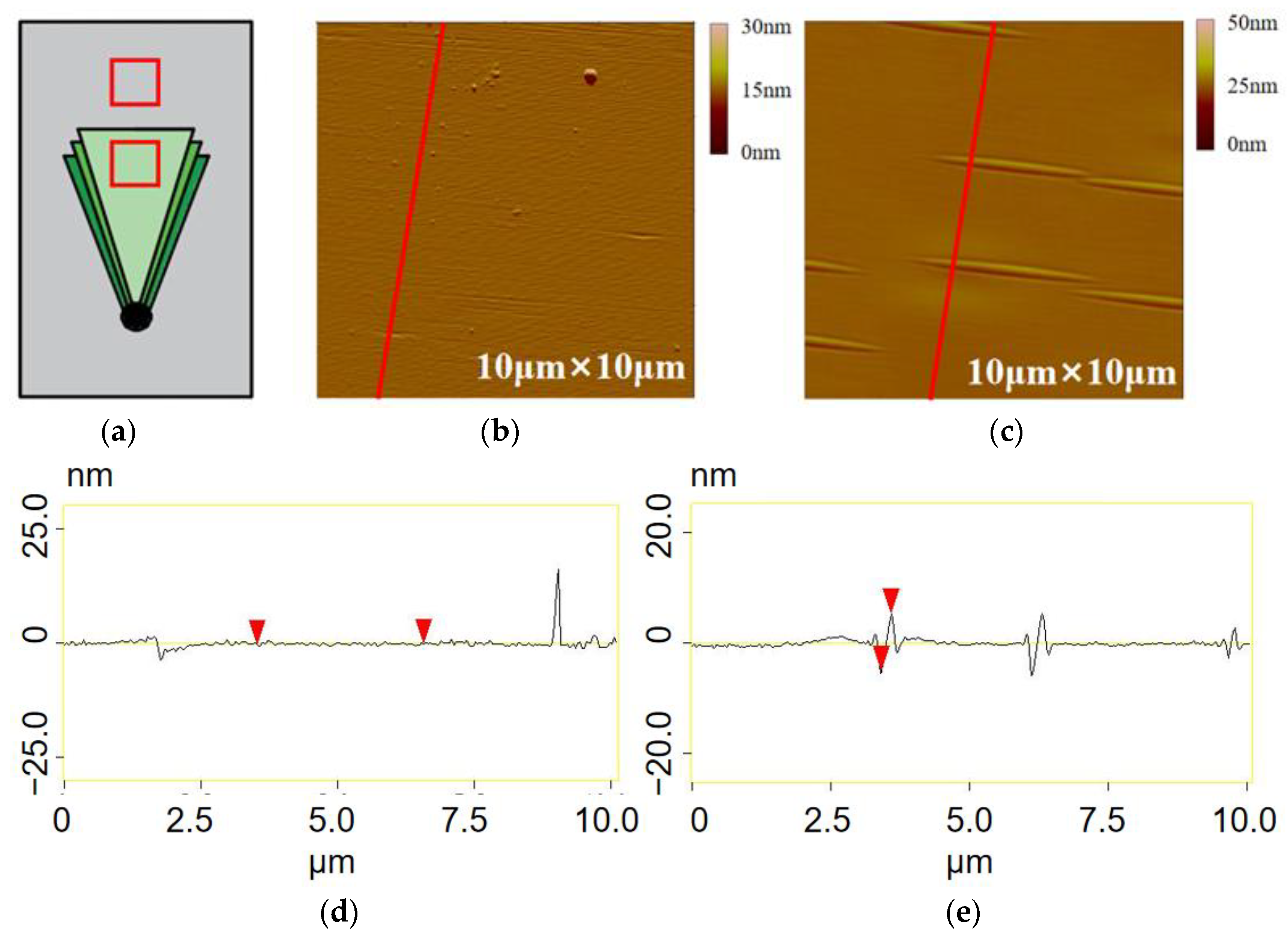Multiple-Layer Triangular Defects in 4H-SiC Homoepitaxial Films Grown by Chemical Vapor Deposition
Abstract
:1. Introduction
2. Materials and Methods
3. Results
3.1. Composition of Defect
3.2. Microstructure
3.3. Influence Methods
4. Discussion
5. Conclusions
Author Contributions
Funding
Data Availability Statement
Conflicts of Interest
References
- Xu, M.; Girish, Y.R.; Rakesh, K.P.; Wu, P.; Manu Kumar, H.M.; Byrappa, S.M.; Udayabhanu; Byrappa, K. Recent advances and challenges in silicon carbide (SiC) ceramic nanoarchitectures and their applications. Mater. Today Commun. 2021, 28, 102533. [Google Scholar] [CrossRef]
- Kaloyeros, A.E.; Goff, J.; Arkles, B. Defect- and H-Free Stoichiometric Silicon Carbide by Thermal CVD from the Single Source Precursor Trisilacyclohexane. Electron. Mater. 2022, 3, 27–40. [Google Scholar] [CrossRef]
- Zhao, Z.; Li, Y.; Xia, X.; Wang, Y.; Zhou, P.; Li, Z. Growth of high-quality 4H-SiC epitaxial layers on 4° off-axis C-face 4H-SiC substrates. J. Cryst. Growth 2020, 531, 125355. [Google Scholar] [CrossRef]
- He, Y.; Yuan, Z.; Song, S.; Gao, X.; Deng, W. Investigation on Material Removal Mechanisms in Photocatalysis-Assisted Chemical Mechanical Polishing of 4H–SiC Wafers. Int. J. Precis. Eng. Manuf. 2021, 22, 951–963. [Google Scholar] [CrossRef]
- Wellmann, P.J. Review of SiC Crystal Growth Technology. Semicond. Sci. Technol. 2018, 33, 103001. [Google Scholar] [CrossRef]
- Matsunami, H. Fundamental research on semiconductor SiC and its applications to power electronics. Proc. Jpn. Acad. Ser. B-Phys. Biol. Sci. 2020, 96, 235–254. [Google Scholar] [CrossRef]
- Dong, L.; Sun, G.S.; Yu, J.; Zheng, L.; Liu, X.F.; Zhang, F.; Yan, G.G.; Li, X.G.; Wang, Z.G.; Yang, F. Characterization of Obtuse Triangular Defects on 4H-SiC 4° off-Axis Epitaxial Wafers. Chin. Phys. Lett. 2013, 30, 96105. [Google Scholar] [CrossRef]
- Chaudhuri, S.; Mandal, K. Radiation Detection Using n-Type 4H-SiC Epitaxial Layer Surface Barrier Detectors. In Advanced Materials for Radiation Detection; Springer: Berlin/Heidelberg, Germany, 2022; pp. 183–209. ISBN 978-3-030-76461-6. [Google Scholar]
- Napoli, M.D. SiC detectors: A review on the use of silicon carbide as radiation detection material. Front. Phys. 2022, 10, 769. [Google Scholar] [CrossRef]
- Mandal, K.C.; Krishna, R.; Muzykov, P.G.; Laney, Z.; Sudarshan, T.S. Radiation Detectors Based on 4H Semi-Insulating Silicon Carbide. In Proceedings of the International Society for Optics and Photonics, Wuhan, China, 2–5 November 2010; Volume 7805, pp. 158–165. [Google Scholar]
- Saitoh, H.; Kimoto, T. 4H-SiC Epitaxial Growth on SiC Substrates with Various Off-Angles. In Proceedings of the Materials Science Forum, Boston, MA, USA, 28 November–2 December 2005; Volume 483, pp. 89–92. [Google Scholar]
- Kimoto, T.; Yonezawa, Y. Current status and perspectives of ultrahigh-voltage SiC power devices. Mater. Sci. Semicond. Process. 2018, 78, 43–56. [Google Scholar] [CrossRef]
- Pedersen, H.; Leone, S.; Kordina, O.; Henry, A.; Nishizawa, S.-i.; Koshka, Y.; Janzén, E. Chloride-Based CVD Growth of Silicon Carbide for Electronic Applications. Chem. Rev. 2012, 112, 2434–2453. [Google Scholar] [CrossRef]
- Liu, X.F.; Yan, G.G.; Liu, B.; Shen, Z.W.; Wen, Z.X.; Chen, J.; Zhao, W.S.; Wang, L.; Zhang, F.; Sun, G.S.; et al. Process optimization for homoepitaxial growth of thick 4H-SiC films via hydrogen chloride chemical vapor deposition. J. Cryst. Growth 2018, 504, 7–12. [Google Scholar] [CrossRef]
- La Via, F.; Camarda, M.; La Magna, A. Mechanisms of growth and defect properties of epitaxial SiC. Appl. Phys. Rev. 2014, 1, 031301. [Google Scholar] [CrossRef]
- Fujiwara, H.; Naruoka, H.; Konishi, M.; Hamada, K.; Katsuno, T.; Ishikawa, T.; Watanabe, Y.; Endo, T. Impact of Surface Morphology above Threading Dislocations on Leakage Current in 4H-SiC Diodes. Appl. Phys. Lett. 2012, 101, 042104. [Google Scholar] [CrossRef]
- Taishi, T.; Hoshikawa, T.; Yamatani, M.; Shirasawa, K.; Huang, X.; Uda, S.; Hoshikawa, K. Influence of crystalline defects in Czochralski-grown Si multicrystal on minority carrier lifetime. J. Cryst. Growth 2007, 306, 452–457. [Google Scholar] [CrossRef]
- Zhao, L. Surface defects in 4H-SiC homoepitaxial layers. Nanotechnol. Precis. Eng. 2020, 3, 229–234. [Google Scholar] [CrossRef]
- Hu, J.; Jia, R.; Xin, B.; Peng, B.; Wang, Y.; Zhang, Y. Effect of Low Pressure on Surface Roughness and Morphological Defects of 4H-SiC Epitaxial Layers. Materials 2016, 9, 743. [Google Scholar] [CrossRef] [Green Version]
- Niu, Y.X.; Tang, X.Y.; Jia, R.X.; Sang, L.; Hu, J.C.; Yang, F.; Wu, J.M.; Pan, Y.; Zhang, Y.M. Influence of Triangle Structure Defect on the Carrier Lifetime of the 4H-SiC Ultra-Thick Epilayer. Chin. Phys. Lett. 2018, 35, 077103. [Google Scholar] [CrossRef]
- Kakanakova-Georgieva, A.; Ivanov, I.G.; Suwannaharn, N.; Hsu, C.-W.; Cora, I.; Pécz, B.; Giannazzo, F.; Sangiovanni, D.G.; Gueorguiev, G.K. MOCVD of AlN on epitaxial graphene at extreme temperatures. CrystEngComm 2021, 23, 385–390. [Google Scholar] [CrossRef]
- Sangiovanni, D.G.; Faccio, R.; Gueorguiev, G.K.; Kakanakova-Georgieva, A. Discovering atomistic pathways for supply of metal atoms from methyl-based precursors to graphene surface. Phys. Chem. Chem. Phys. 2022, 25, 829–837. [Google Scholar] [CrossRef]
- Wu, P.; Emorhokpor, E.; Yoganathan, M.; Kerr, T.; Zhang, J.; Romano, E.; Zwieback, I. Dislocation in 4H n+ SiC Substrates and their Relationship with Epilayer Defects. In Proceedings of the Materials Science Forum, Boston, MA, USA, 26–30 November 2007; Volume 556, pp. 247–250. [Google Scholar]
- Matsunami, H.; Kimoto, T. Step-controlled epitaxial growth of SiC: High quality homoepitaxy. Mater. Sci. Eng. R Rep. 1997, 20, 125–166. [Google Scholar] [CrossRef]
- Hallin, C.; Konstantinov, A.O.; Pécz, B.; Kordina, O.; Janzén, E. The origin of 3C polytype inclusions in epitaxial layers of silicon carbide grown by chemical vapour deposition. Diam. Relat. Mater. 1997, 6, 1297–1300. [Google Scholar] [CrossRef]
- Zhao, L.; Wu, H. A correlation study of substrate and epitaxial wafer with 4H-N type silicon carbide. J. Cryst. Growth 2019, 507, 109–112. [Google Scholar] [CrossRef]
- Li, Y.; Zhao, Z.; Yu, L.; Wang, Y.; Zhou, P.; Niu, Y.; Li, Z.; Chen, Y.; Han, P. Reduction of morphological defects in 4H-SiC epitaxial layers. J. Cryst. Growth 2019, 506, 108–113. [Google Scholar] [CrossRef]
- Wang, J.; Zhao, S.; Yan, G.; Shen, Z.; Zhao, W.; Wang, L.; Liu, X. Investigation on Step-Bunched Homoepitaxial Layers Grown on On-Axis 4H-SiC Substrates via Molten KOH Etching. Crystals 2022, 12, 788. [Google Scholar] [CrossRef]









Disclaimer/Publisher’s Note: The statements, opinions and data contained in all publications are solely those of the individual author(s) and contributor(s) and not of MDPI and/or the editor(s). MDPI and/or the editor(s) disclaim responsibility for any injury to people or property resulting from any ideas, methods, instructions or products referred to in the content. |
© 2023 by the authors. Licensee MDPI, Basel, Switzerland. This article is an open access article distributed under the terms and conditions of the Creative Commons Attribution (CC BY) license (https://creativecommons.org/licenses/by/4.0/).
Share and Cite
Pei, Y.; Yuan, W.; Guo, N.; Li, Y.; Zhang, X.; Liu, X. Multiple-Layer Triangular Defects in 4H-SiC Homoepitaxial Films Grown by Chemical Vapor Deposition. Crystals 2023, 13, 1056. https://doi.org/10.3390/cryst13071056
Pei Y, Yuan W, Guo N, Li Y, Zhang X, Liu X. Multiple-Layer Triangular Defects in 4H-SiC Homoepitaxial Films Grown by Chemical Vapor Deposition. Crystals. 2023; 13(7):1056. https://doi.org/10.3390/cryst13071056
Chicago/Turabian StylePei, Yicheng, Weilong Yuan, Ning Guo, Yunkai Li, Xiuhai Zhang, and Xingfang Liu. 2023. "Multiple-Layer Triangular Defects in 4H-SiC Homoepitaxial Films Grown by Chemical Vapor Deposition" Crystals 13, no. 7: 1056. https://doi.org/10.3390/cryst13071056
APA StylePei, Y., Yuan, W., Guo, N., Li, Y., Zhang, X., & Liu, X. (2023). Multiple-Layer Triangular Defects in 4H-SiC Homoepitaxial Films Grown by Chemical Vapor Deposition. Crystals, 13(7), 1056. https://doi.org/10.3390/cryst13071056





